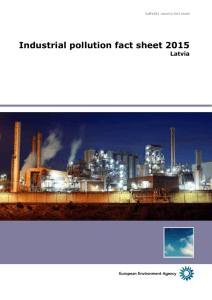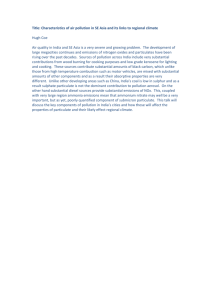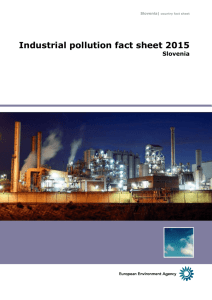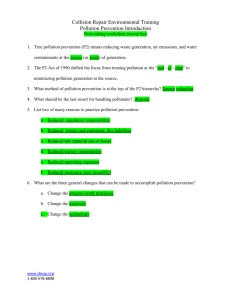Industry_Factsheet_IS - Eionet Forum
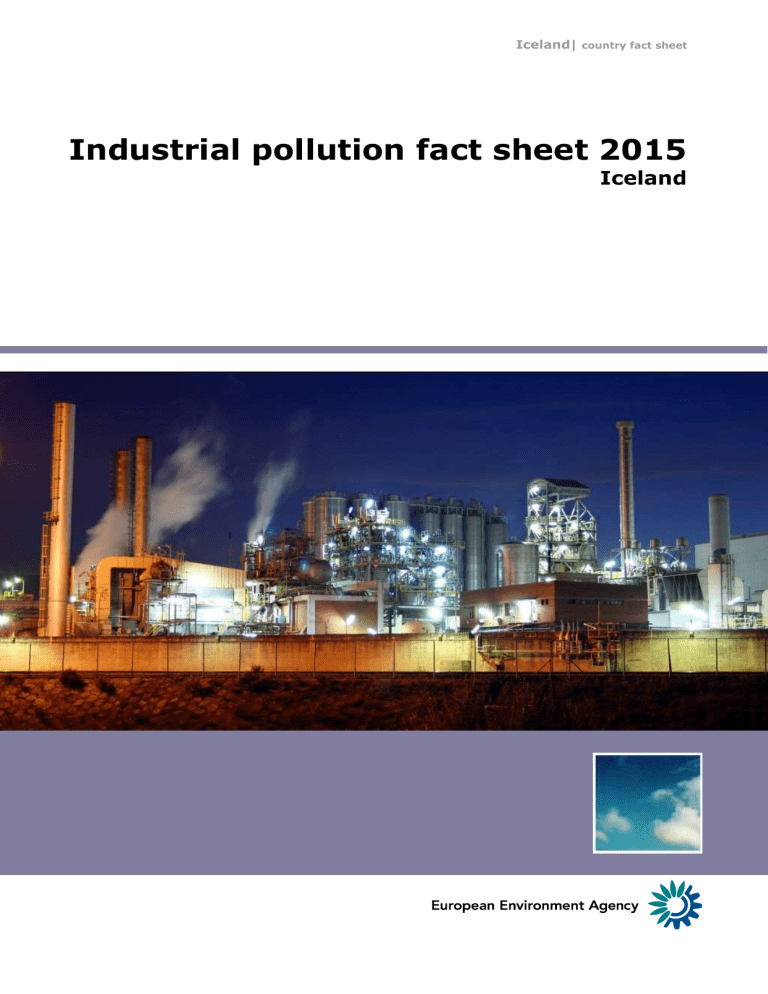
Iceland| country fact sheet
Industrial pollution fact sheet 2015
Iceland
Iceland | country fact sheet
Cover design: EEA
Cover photo: Jorge Franganillo, Creative Commons Attribution 2.0 Generic ( https://goo.gl/rqHYk6 )
Layout: EEA
Acknowledgments
This country fact sheet was prepared by the European Environment Agency in cooperation with the European Topic Centre for Air Pollution and Climate Change
Mitigation.
Content
Introduction
………………………….……………………………………………………….………...
Significance of industry
………………………………………………….…………………………
Significance of industry in terms of gross value added
3
4
Significance of industry in terms of energy consumption
Significance of industry in terms of water consumption
Industrial emissions to air
……………………………………………………………………....
Significance of industry in terms of emissions to air
Emission trend for key air pollutants and decoupling
Industrial emissions to water
…………………………………………………………………...
Significance of industry in terms of emissions to air
Emission trend for key air pollutants and decoupling
Industrial waste generation
……………………………………………………………………..
Significance of industry in terms of generation of waste
Waste generation trend and decoupling
References
……………………………………………………………………………………………….
7
9
11
14
Industrial pollution country fact sheets 2015 2
Iceland | country fact sheet
Introduction
Industry across the data sources
While industry makes a significant contribution to the economic welfare and development of a country, pollution from industrial activities can also negatively impact people and the environment. These impacts (such as premature deaths, and damage to ecosystems) occur as a result of releases to air and water, through the disposal of waste, and through the demand for resources and energy. Industrial sources still contribute a substantial share of total pollution in
Europe. Pollution from industry is subject to national, European, and international regulations and standards to limit releases, waste and resource use.
Data sources
These factsheets present a set of graphs and tables that show the significance of industrial pollution using data taken from several sources:
Eurostat’s statistics on environment (ESTAT, 2015a) and energy (ESTAT, 2015b) and economy and finance statistics (ESTAT, 2015c)
The European Pollutant Release and Transfer Register (E-PRTR) (EEA, 2015a)
The European Environment Agency’s compilation of the national greenhouse gas inventories to be reported to the United Nations Framework Convention on Climate
Change (EEA, 2015b)
The European Environment Agency’s compilation of data on emissions of air pollutants to be submitted to the Convention on Long-range Transboundary Air Pollution (EEA, 2015c)
This country fact sheet includes data available as of 31 December 2015.
Definition of industry
Due to the diverging legal definitions of industry in the different datasets, certain assumptions have been made to enable the presentation of industry in a consistent way (see the methodology document for more details).
What is industry?
Industry is the production of goods or services within an economy. The different data sources used in these fact sheets interpret this definition in slightly different ways. These fact sheets have attempted to cover comparable activities across the different databases that were used. In summary, the activities selected across the datasets are: energy industry, metal production, cement and lime production, mining and quarrying, chemical industry, manufacturing, waste industry (including water and sewage management), and distribution of electricity, gas, steam and air conditioning.
The energy used for transport in the above industrial activities (except pipelines for the transmission of energy), and agricultural activities, are not included.
Methodology
The detailed methodology for the development of this country fact sheet is available at the Eionet forum 1 .
Country coverage
These country factsheets cover all European Environment Agency (EEA) member countries. The current EEA membership, comprising 33 countries and referred to as EEA33, include the 28
European Union Member States together with Iceland, Liechtenstein, Norway, Switzerland and
Turkey.
Therefore, the graphs and tables presented in this document offer data of Iceland and the rest of the EEA member countries. However, in some cases data were not available for one or more countries. Below each table and figure, the source and the countries for which data were missing are included.
1 http://forum.eionet.europa.eu/nrc-industrial-pollution/library/consultations
Industrial pollution country fact sheets 2015 3
Iceland | country fact sheet
Significance of industry
S IGNIFICANCE OF INDUSTRY WITHIN THE ECONOMY IN TERMS OF GROSS VALUE ADDED
This section shows the significance of industry in the context of the economy. The parameter used is gross value added (GVA), which captures the value in terms of goods and services provided by an economic activity.
Figure 1. GVA of industry as % of EEA33 economy, and within Iceland, 2013
Source: ESTATc, 2015. Data gap-filled according to methodology
Figure 2. Evolution of GVA of industry in Iceland, €billion, 2000-2013
Source: ESTATc, 2015. Data gap-filled according to methodology
GVA (B€) 2006 2007 2008
Manufacturing
Electricity, gas (…)
Mining & qarrying
Waste management
Total industry
-
-
-
-
3.7
-
-
-
-
3.9
-
-
-
-
3.1
2009
-
-
-
-
2.1
2010
-
-
-
-
2.4
2011
-
-
-
-
2.5
S IGNIFICANCE OF INDUSTRY IN TERMS OF ENERGY CONSUMPTION
2012
-
-
-
-
2.7
2013
-
-
-
-
2.7
Industrial pollution country fact sheets 2015 4
Iceland | country fact sheet
This section shows the significance of industry as an energy consumer. The parameter used is final energy consumption, which accounts for the energy supplied to the consumer (i.e. industry) for all energy used involved to run the processes in the industrial activities considered in this fact sheet.
Figure 3. Energy consumption of industry as % of EEA33 energy consumption, and within Iceland, 2013
Source: ESTAT, 2015b. No data for LI. Data gap-filled according to methodology
Figure 4. Evolution of energy consumption of industry, broken down by sectors, within Iceland, Petajoules
(PJ), 1990-2013
Source: ESTAT, 2015b. Data gap-filled according to methodology
Energy consumption
(PJ)
2006 2007 2008 2009
Chemical industry
Manufacturing
Metal industry
Mining & quarrying
Other industry
Total industry
-
-
-
-
-
35.2
-
-
-
-
-
40.4
-
-
-
-
-
54.7
-
-
55.0
-
-
-
2010
-
-
54.7
-
-
-
2011
S IGNIFICANCE OF INDUSTRY IN TERMS OF WATER USAGE
-
-
55.7
-
-
-
2012
-
-
57.1
-
-
-
2013
-
-
61.6
-
-
-
Industrial pollution country fact sheets 2015 5
Iceland | country fact sheet
This section shows the significance of industry as a water consumer. The parameter used is water usage, which accounts for the water supplied to the consumer (i.e. industry) for all water uses needed to run the processes in the industrial activities considered in this fact sheet.
Figure 5. Water usage by industry as % of EEA33 water usage, and within Iceland, 2013
Source: ESTAT, 2015a. No data for LI. Data gap-filled according to methodology
Figure 6. Evolution of industrial water usage within Iceland, million cubic meters (Mm 3 ), 1990-2013
Source: ESTATa, 2015. No data for LI. Data gap-filled according to methodology
Water consumption
2006 2007 2008 2009 2010
(Mm 3 )
Manufacturing 5.7 5.9 6.0 6.2 6.3
Mining & quarrying
Electricity, gas (…)
Total industry
-
-
5.7
-
-
5.9
-
-
6.0
-
-
6.2
-
-
6.3
2011
6.5
-
-
6.5
2012
6.6
-
-
6.6
2013
6.6
-
-
6.6
Industrial pollution country fact sheets 2015 6
Iceland | country fact sheet
Industrial emissions to air
S IGNIFICANCE OF INDUSTRY IN TERMS OF EMISSIONS TO AIR
Air pollution harms human health and the environment. In Europe, emissions of many air pollutants have decreased substantially in recent decades, resulting in improved air quality across the region. However, air pollutant concentrations are still high, and air quality problems persist. The selected pollutants for which data are provided in this section are those that cause significant pressure on the environment and human health. Nitrogen oxides
(NO x
), sulphur oxides (SO x
) and ammonia (NH
3
) cause acidification and eutrophication. Non-methane volatile organic compounds (NMVOC) and particulate matter (PM
10
) play a key role in air quality, especially in the so-called smog. Finally, the release of heavy metals lead to their accumulation in the food chain, an issue of concern given their toxicity. The heavy metals considered are arsenic (As), chromium (Cr), lead (Pb), and mercury (Hg).
Figure 7. Industrial air emissions as % of total country pollution, by sector origins, 2013 – Iceland
For each pollutant, the coloured sections of the bars represent the contribution of the different industrial sectors.
The grey areas refer to the contribution of the rest of the human activities (other than industry). The quantities, expressed in percentages, refer to the country’s total air emissions of each pollutant. The smaller the grey area the bigger the significance of industrial releases for the concerned pollutant. In the CLRTAP, NO x
is reported as nitric oxide and nitrogen dioxide, expressed as nitrogen dioxide (NO
2
), and SO x as sulphur dioxide (SO
2 hydrogem sulphide, mercaptans and dimethul sulphides, etc.)
covers all sulphur compounds expressed
) (including sulphur trioxide, sulphuric acid, and reduced sulphur compounds, such as
Source: EEA, 2015c
Emissions (tonnes)
Cement production and
Chemical industry
Energy industry
Food & drink industry lime
Iron & steel manufacturing
Mining & quarrying
Non-ferrous production
Other manufacturing metal
Pulp, paper, & wood (…)
Waste industry
As
-
Cr Hg
- -
-
-
-
-
-
-
-
-
-
- -
-
-
-
-
-
- -
- -
-
NH
3
-
-
-
NMVOC
-
NO x
(as
NO
2
)
-
Pb
-
PM
10
-
SO x
(as
SO
2
)
0.70
3.96
15.85
- 470.63
-
-
0.27
-
- 110.79
- -
- -
- 343.89
- -
- - 19.97 193.24
-
120.94
-
2.13
-
2 192.65
70.74
-
19.97
-
-
-
-
-
-
-
-
-
-
-
-
365.70
-
0.99
- 52 534.59
- 425.50 15 621.64
- 11.77 2 001.35
- - -
18.86
Industrial pollution country fact sheets 2015 7
Iceland | country fact sheet
Non industry - - - 4
039.06
3
817.52
16 051.02 - 115.26 2 013.84
E MISSIONS TRENDS FOR KEY AIR POLLUTANTS
Emissions and economic growth trends are often coupled. EU policy aims, among other objectives, at decoupling economic growth from emissions, and driving down emission trends, whilst allowing economies to continue to grow. Decoupling of industrial emissions from industry GVA growth can be absolute (emissions decrease where
GVA increases) or relative (emissions increase at a slower rate than GVA). Selected pollutants emissions, indexed to 2007, are presented together with GVA (also indexed to 2007) to show the coupling or decoupling of pollutant releases with economic growth.
Figure 8. Industrial air pollution versus the economy (non heavy metals), Iceland, 2007-2013
Source: EEA, 2015a
Emissions (tonnes)
NH
3
NMVOC
NO x
/NO
2
2007
13
-
885
2008
12
-
-
2009
-
-
-
2010
13
-
-
2011
18
-
-
2012
11
-
-
PM
10
SO x
/SO
2
839
7 545
853
11 870
497
12 280
458
12 750
92 79
42 380 13 050
Figure 9. Industrial air pollution versus the economy (heavy metals), Iceland, 2007-2013
Source: EEA, 2015a
2013
48
-
-
307
14 310
Emissions (kg)
As
Cr
Hg
Pb
2007
-
-
-
-
2008
-
-
-
-
2009
-
-
-
-
2010
-
-
-
-
2011
-
-
-
-
2012
-
-
-
-
2013
-
-
-
-
Industrial pollution country fact sheets 2015 8
Iceland | country fact sheet
Industrial emissions to water
S IGNIFICANCE OF INDUSTRY IN TERMS OF EMISSIONS TO WATER
Industrial activities are an important source of water pollution. Industry realeases pollutants that can be harmful to people and the environment. In this section, data are provided for the heavy metals arsenic (As), cadmium
(Cd), chromium (Cr), copper (Cu), mercury (Hg), nickel (Ni), lead (Pb), zinc (Zn); the nutrients nitrogen (Tot-N) and phosphorus (Tot-P); and the total organic carbon content (TOC).
For each pollutant, the coloured sections of the bars represent the contribution of the different industrial sectors.
The sector’s contributions, expressed in percentages, refer to the country’s total industrial water emissions of each pollutant as reported to the European Pollutant Release and Transfer Register (E-PRTR).
For water releases, there are no complete inventories of emissions covering all human activities. That is why the data source for this medium is the E-PRTR. This dataset only covers releases above a certain threshold for selected industrial activities. Therefore, this graph captures a subset of the industrial reality. In the E-PRTR heavy metals include compounds.
Figure 10. Industrial water emissions as % of total country E-PRTR pollution, by sector origins, 2013 – Iceland
Source: EEA, 2015a
Emissions (tonnes)
Electricity, gas, steam
(…)
Manufacturing
Mining & quarrying
Waste management (…)
As
-
-
-
-
Cd
-
-
-
-
Cr
-
Cu
-
- 0.05
- -
- -
Hg
-
-
-
-
Ni
-
-
-
-
Pb
-
TOC
-
Tot-N Tot-P Zn
- - -
- 280.00 163.00 24.55
- - - -
- - - -
-
-
-
Industrial pollution country fact sheets 2015 9
Iceland | country fact sheet
E MISSIONS TRENDS FOR KEY WATER POLLUTANTS
This section presents indexed data on emissions (annual loads) and growth (GVA) to show the possible decoupling of economy and environment pressures. An explanation of this concept is in the same section for air pollutants (page 8).
Figure 11. Industrial water pollution versus the economy, Iceland, 2007-2013
Source: EEA, 2015a
Note: As heavy metals in water represent a comparable pressure to the environment, they can be aggregated by their relative toxicity. The methodology document includes details on this aggregation. The heavy metal releases are weighted by factors corresponding to the reciprocal
Predicted No Effect Concentrations (PNEC) values (1/PNEC) (OSPAR, 2014) for each pollutant and set equivalent to one of the metals - here
Mercury has been chosen.
2013 Emissions (tonnes)
Heavy Metals (Hg specific)
Total Organic Carbon
(TOC)
Tot-N
Tot-P
2007
60
55
-
2008
58
285
-
2009 2010 2011
See individual pollutants in table below.
56
286
-
104
218
32
199
155
12
2012
Figure 12. Industrial water pollution versus the economy (Heavy Metals), Iceland, 2007-2013
371
246
19
280
163
25
Source: EEA, 2015a
Emissions (kg)
As
Cd
Cr
Cu
Hg
Ni
Pb
Zn
2007
-
-
-
-
-
-
-
-
2008
-
-
-
-
-
-
-
-
2009
-
-
-
-
-
-
-
-
2010
-
-
-
-
-
-
-
-
2011
-
-
-
-
-
-
-
-
2012
-
-
-
-
-
-
-
-
2013
-
-
-
-
-
-
-
-
Industrial pollution country fact sheets 2015 10
Iceland | country fact sheet
Waste generation
S IGNIFICANCE OF INDUSTRY IN TERMS OF GENERATION OF WASTE
The waste produced by industrial activities consists of sources such as chemical solvents, paints, paper products, industrial by-products, and metals. In the following analysis, data concerning industrial waste are grouped into three types: hazardous waste, non-hazardous waste, and waste from mining and quarrying.
Hazardous waste can pose a risk to health or the environment if not managed and disposed correctly. The properties of waste which render it hazardous are defined in Annex III to the Waste Directive (EC, 2008), and include being explosive, flammable, toxic, and carcinogenic. Waste from mining and quarrying is presented in its own group, due to the different nature and large volumes of this type of waste. Mining and quarrying waste is waste resulting from the prospecting, extraction, treatment and storage of mineral resources and the working of quarries. This category of waste is also addressed by a separate Directive on the management of waste (EC,
2006).
The following figures on waste generation, show 1) waste intensity (waste (tonnes)/GVA (€millions)), 2) the share of waste generation by the different activities out of the EEA33 total waste generation and 3) the share of country waste generation totals.
Waste intensity quantifies the relationship between the waste generation and economic output. The larger the number, the more waste-generating that country is compared to the GVA the sector produces.
Figure 13. Industrial non hazardous waste generation as % of total EEA waste, with waste intensity, 2012
Source: ESTAT, 2015a. No data for CH.
Industrial pollution country fact sheets 2015 11
Iceland | country fact sheet
Figure 14. Industrial hazardous waste generation as % of total EEA waste, with waste intensity, 2012
Source: ESTAT, 2015a. No data for CH.
Figure 15. Mining and quarrying waste generation as % of total EEA waste, with waste intensity, 2012
Source: ESTAT, 2015a. No data for CH.
Industrial pollution country fact sheets 2015 12
Iceland | country fact sheet
W ASTE GENERATION TREND
This section presents indexed data on waste generation broken down by sectors and growth (GVA) to show the possible coupling or decoupling of the economy and environmental pressures. An explanation of the concept is available in the same section for air pollutants (page 8 of this factsheet). In this case, the data was indexed to
2004 levels.
Figure 16. Decoupling of industrial non-hazardous waste, 2004-2012
Source: ESTAT, 2015a.
Waste (tonnes)
Electricity, gas (…)
2004
-
2006
-
2008
-
2010
1 624
Manufacturing
Mining & quarrying
Waste management
61 000
1 000
1 000
-
-
-
-
-
-
Figure 17. Decoupling of industrial hazardous waste, 2004-2012 (latest years available)
87 463
65
9 207
2012
1 662
90 501
55
4 977
Source: ESTAT, 2015a.
Waste (tonnes)
Electricity, gas (…)
Manufacturing
Mining & quarrying
Waste management
2004
-
12
100
-
2006
-
-
-
-
2008
-
-
-
-
2010
1
736
-
2 913
2012
13
2 596
-
2 925
Industrial pollution country fact sheets 2015 13
Iceland | country fact sheet
References
EC 2006. Directive 2006/21/EC of the European Parliament and of the Council of 15 March
2006 on the management of waste from extractive industries and amending Directive
2004/35/EC ( http://eur-lex.europa.eu/legal-content/EN/TXT/?uri=CELEX:32006L0021 ) accessed 24 November 2015
EC 2008. Directive 2008/98/EC of the European Parliament and of the Council of 19 November
2008 on waste and repealing certain Directives. ( http://eurlex.europa.eu/LexUriServ/LexUriServ.do?uri=OJ:L:2008:312:0003:0030:en:PDF ) accessed 24
November 2015
EEA 2015a. European Pollutant Release and Transfer Register (E-PRTR) v7.0 Dataset.
( http://www.eea.europa.eu/data-and-maps/data/member-states-reporting-art-7-under-theeuropean-pollutant-release-and-transfer-register-e-prtr-regulation-10 ) accessed 24 November
2015
EEA 2015b. European Environment Agency’s compilation of the national greenhouse gas inventories to be reported to the United Nations Framework Convention on Climate Change
(UNFCCC) Dataset. ( http://www.eea.europa.eu/data-and-maps/data/national-emissionsreported-to-the-unfccc-and-to-the-eu-greenhouse-gas-monitoring-mechanism-9 ) accessed 24
November 2015
EEA 2015c. European Environment Agency’s compilation of data on emissions of air pollutants to be submitted to the Convention on Long-range Transboundary Air Pollution
(CLRTAP) Dataset. ( http://www.eea.europa.eu/data-and-maps/data/national-emissionsreported-to-the-convention-on-long-range-transboundary-air-pollution-lrtap-convention-9 ) accessed 24 November 2015
ESTAT 2015a. Eurostat’s statistics on environment
( http://ec.europa.eu/eurostat/data/database tables env_wat_cat env_wat_ind and env_wat_abs and env_wasgt) accessed 24 November 2015
ESTAT 2015b. Eurostat’s statistics on energy ( http://ec.europa.eu/eurostat/data/database table nrg_110a) accessed 24 November 2015
ESTAT 2015c. Eurostat’s statistics on economy and finance statistics
( http://ec.europa.eu/eurostat/data/database table nama_nace64_k) accessed 24 November
2015
OSPAR 2014. Establishment of a list of Predicted No Effect Concentrations (PNECs) for
naturally occurring substances in produced water (OSPAR Agreement 2014-05)
( https://www.gov.uk/government/uploads/system/uploads/attachment_data/file/361476/OSP
AR_RBA_Predicted_No_Effect_Concentrations__PNECs__Background_Document.pdf
) accessed
24 November 2015
Industrial pollution country fact sheets 2015 14



